We had decided to spend 24 hours in Trondheim after we read that there was an interesting food scene there. We also learned that David Nikel, a British travel journalist who gave us good tips about our trip, lives in Trondheim. So it seemed like a reasonable stop on our way to Oslo.
Still, we knew little about Trondheim when we got off the Havila Castor, which brought us from Kirkenes in northern Norway. But it quickly got interesting. The Clarion Hotel wasn’t ready for us when we showed up that Thursday morning, so we left our bags and went out to explore the city. We stopped to look at the canal.
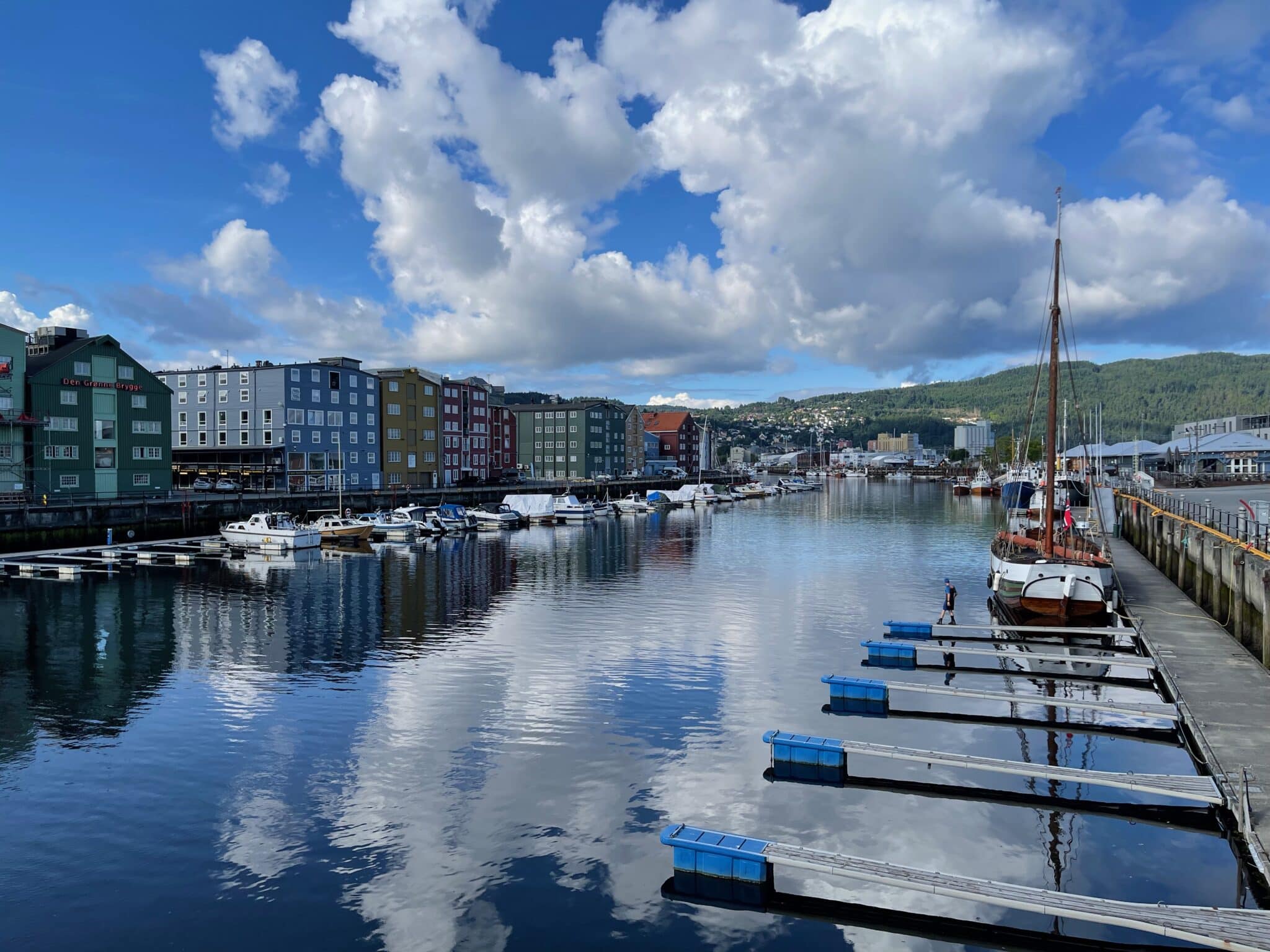
and bumped into our friend Bjorne Tollefsrud from the cruise. He and Beverly were waiting for their train to Lillehammer and it was his turn to take a walkabout. So he took us on a tour of the town.
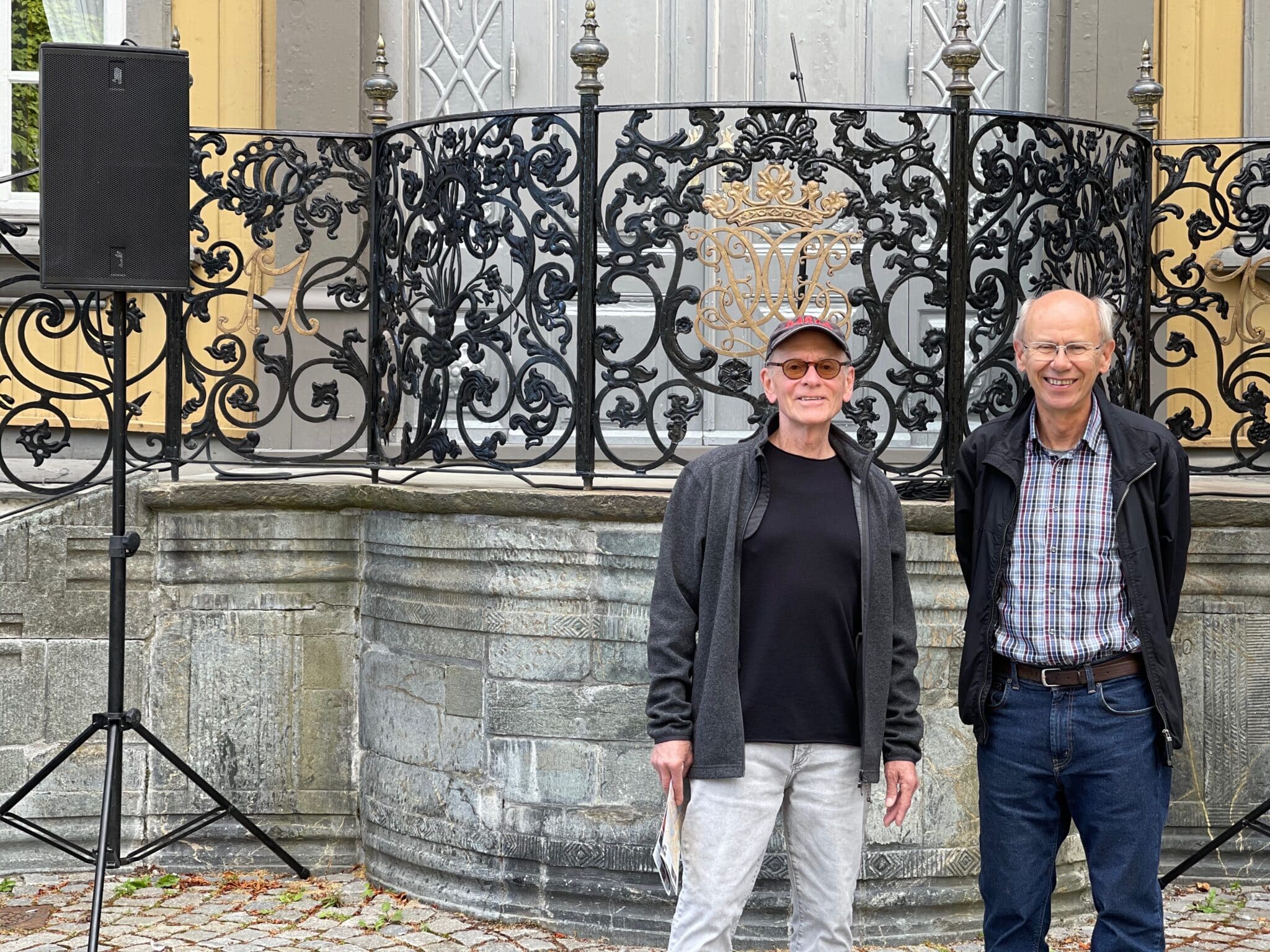
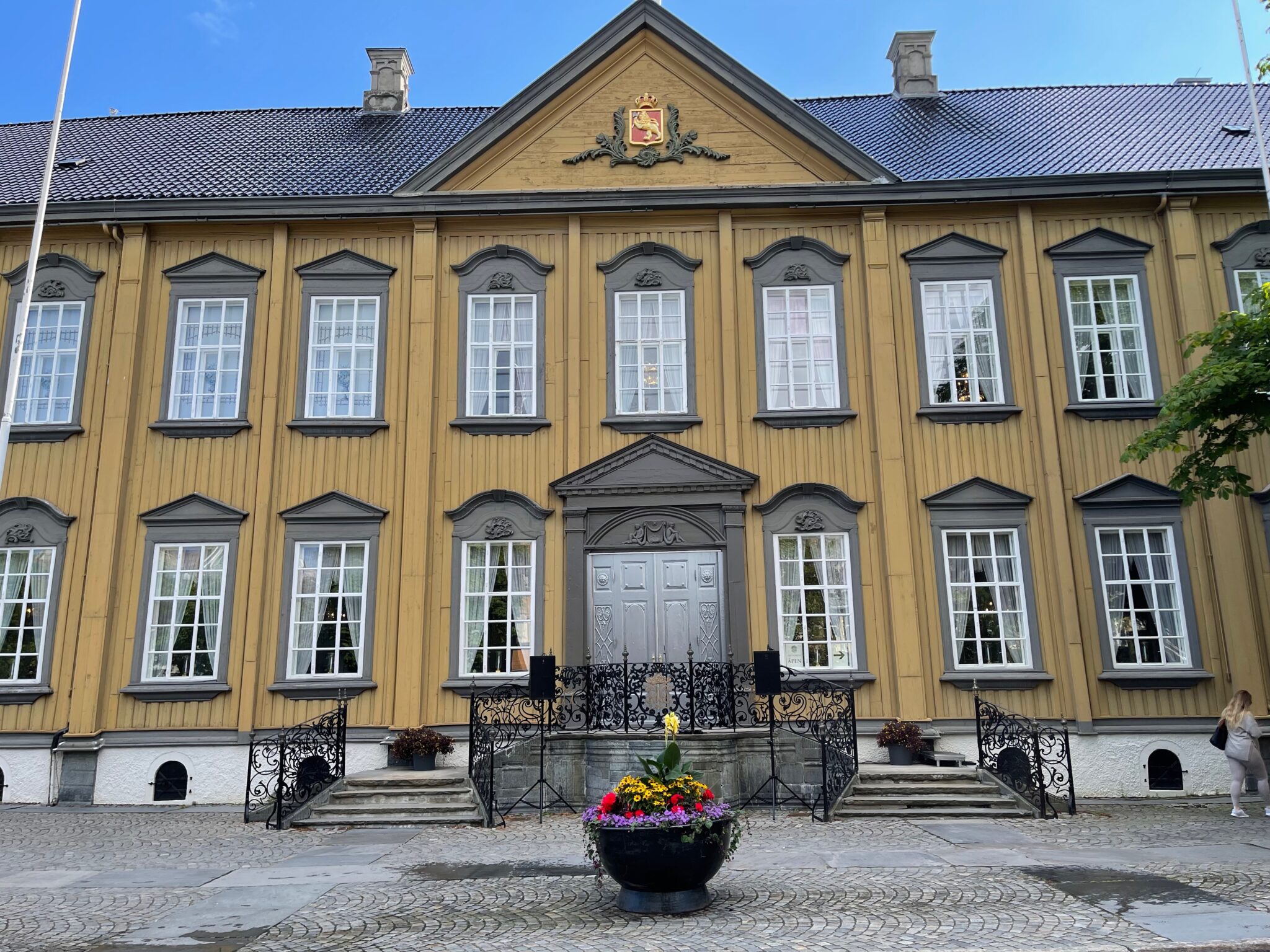
Bjorne said that we had to see the Nidaros Cathedral and he led us through the center of town.
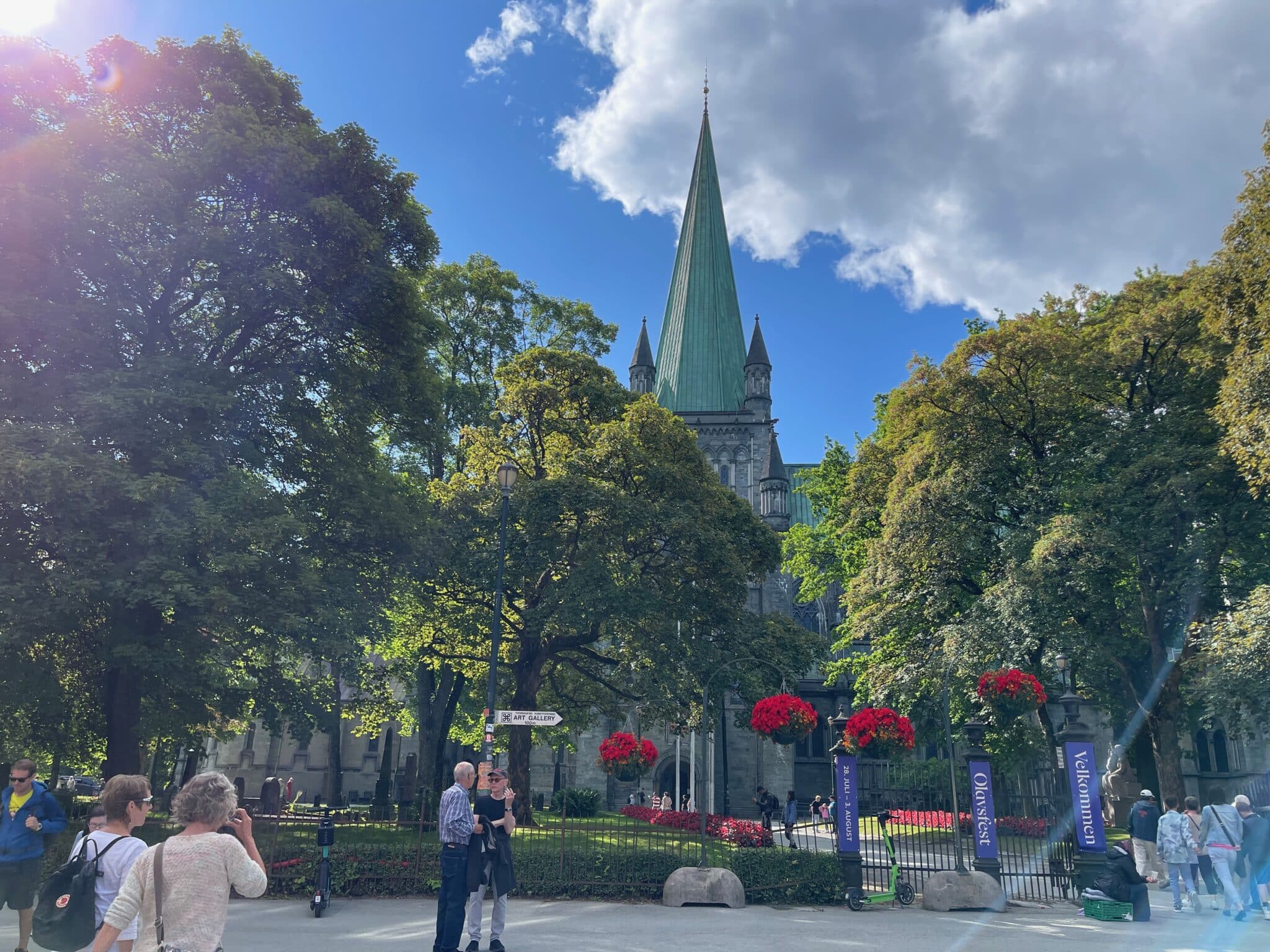
The first stones of this Gothic beauty were laid in 1070 over the tomb of the Viking King Olav II, Olav Haraldsson, who led the push to convert Norway to Christianity and later was declared a saint. The work finished around 1300, then neglect and fires destroyed a lot of it. Restoration started 150 years ago and hasn’t stopped. This is where the monarchs of Norway are crowned.
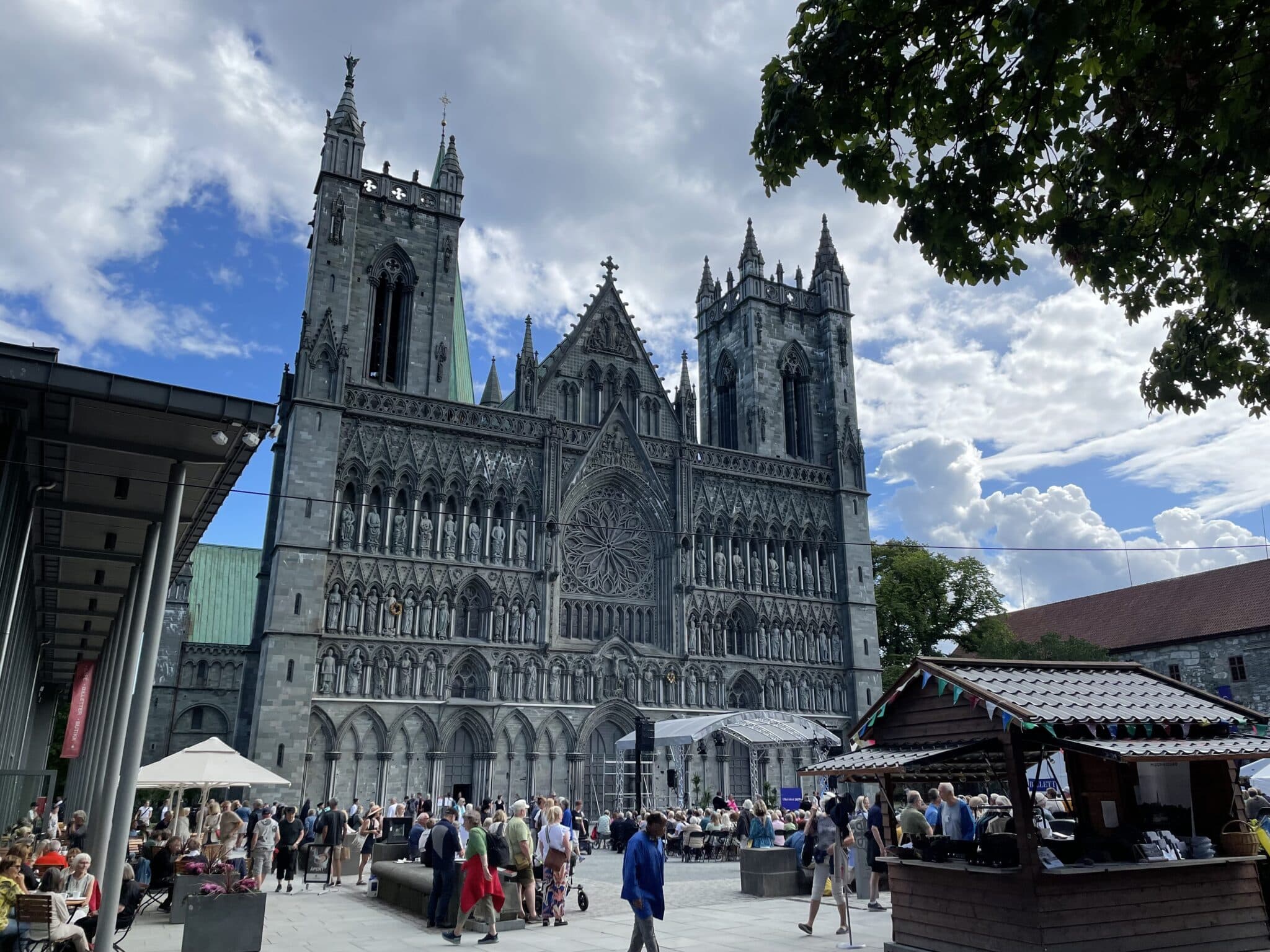
In the 1920s, the rose window in the cathedral’s western facade, replaced one that had disappeared centuries earlier.
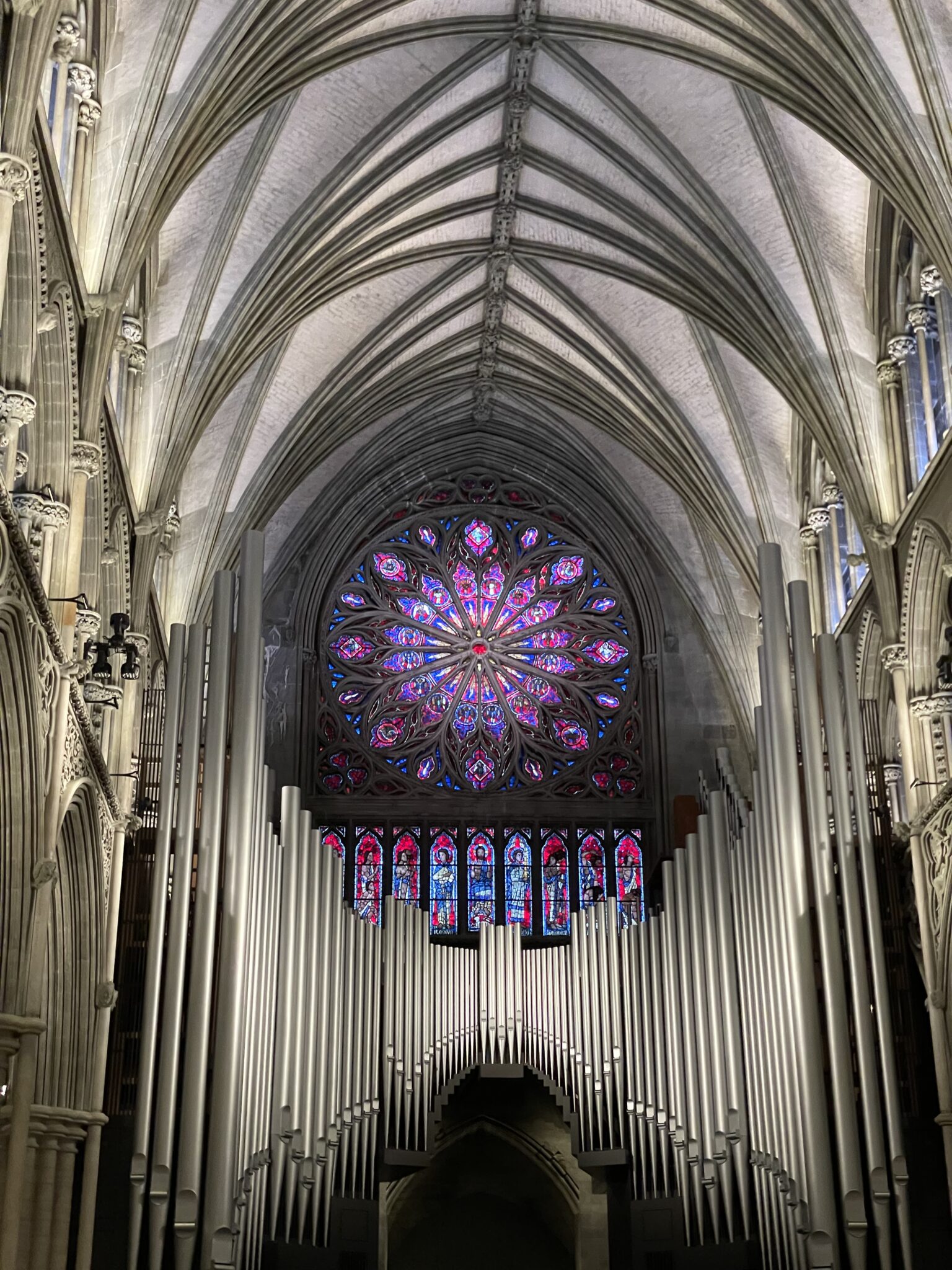
Trondheim is a city of young people because it’s home to the Norwegian University of Science and Technology and Queen Maud University for Early Childhood Education.
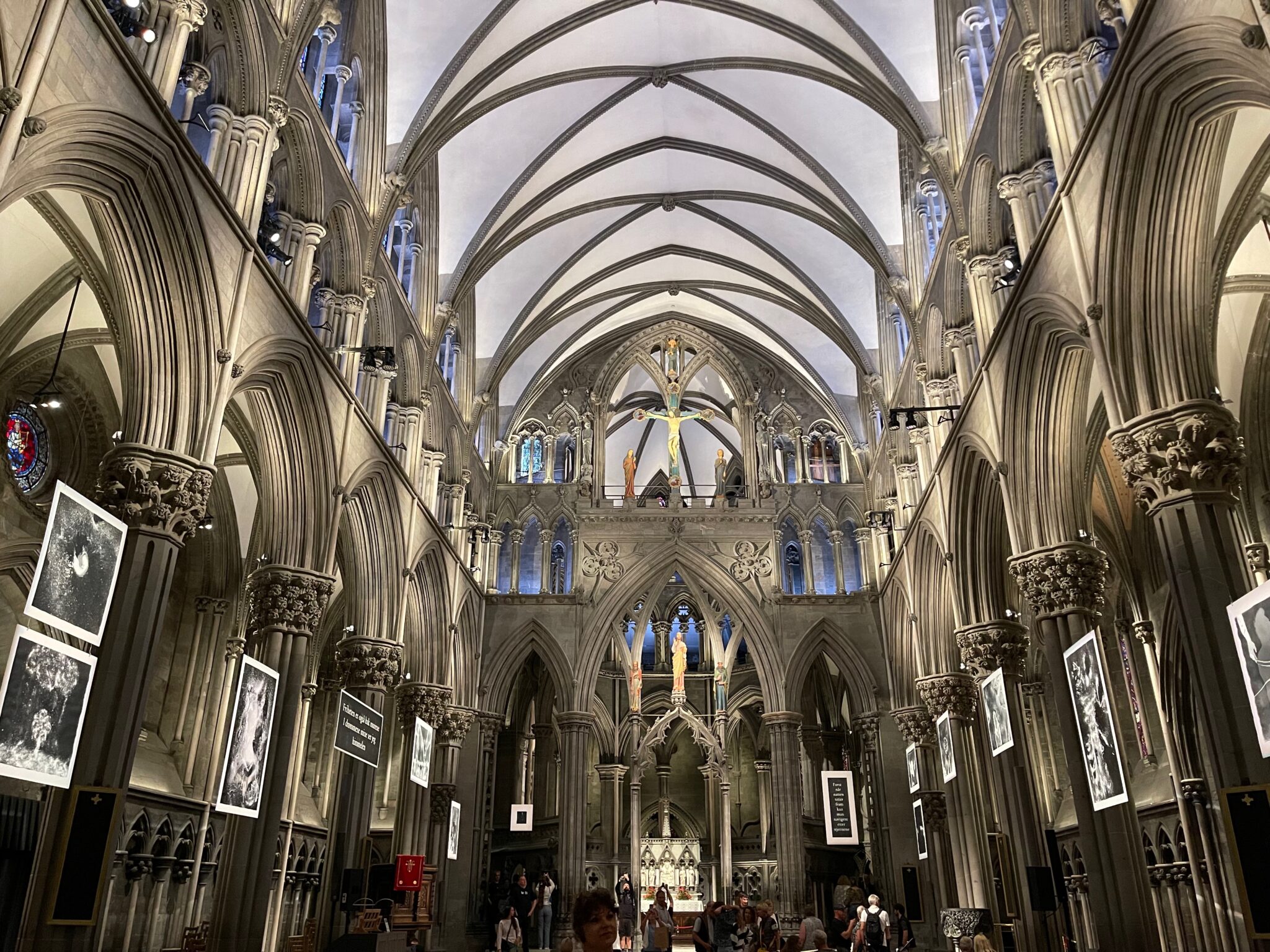
Young guides are on hand in the cathedral to answer questions and give you facts and figures. For example, we learned that the cathedral’s Steinmeyer organ, installed in 1930, is one of Europe’s largest.
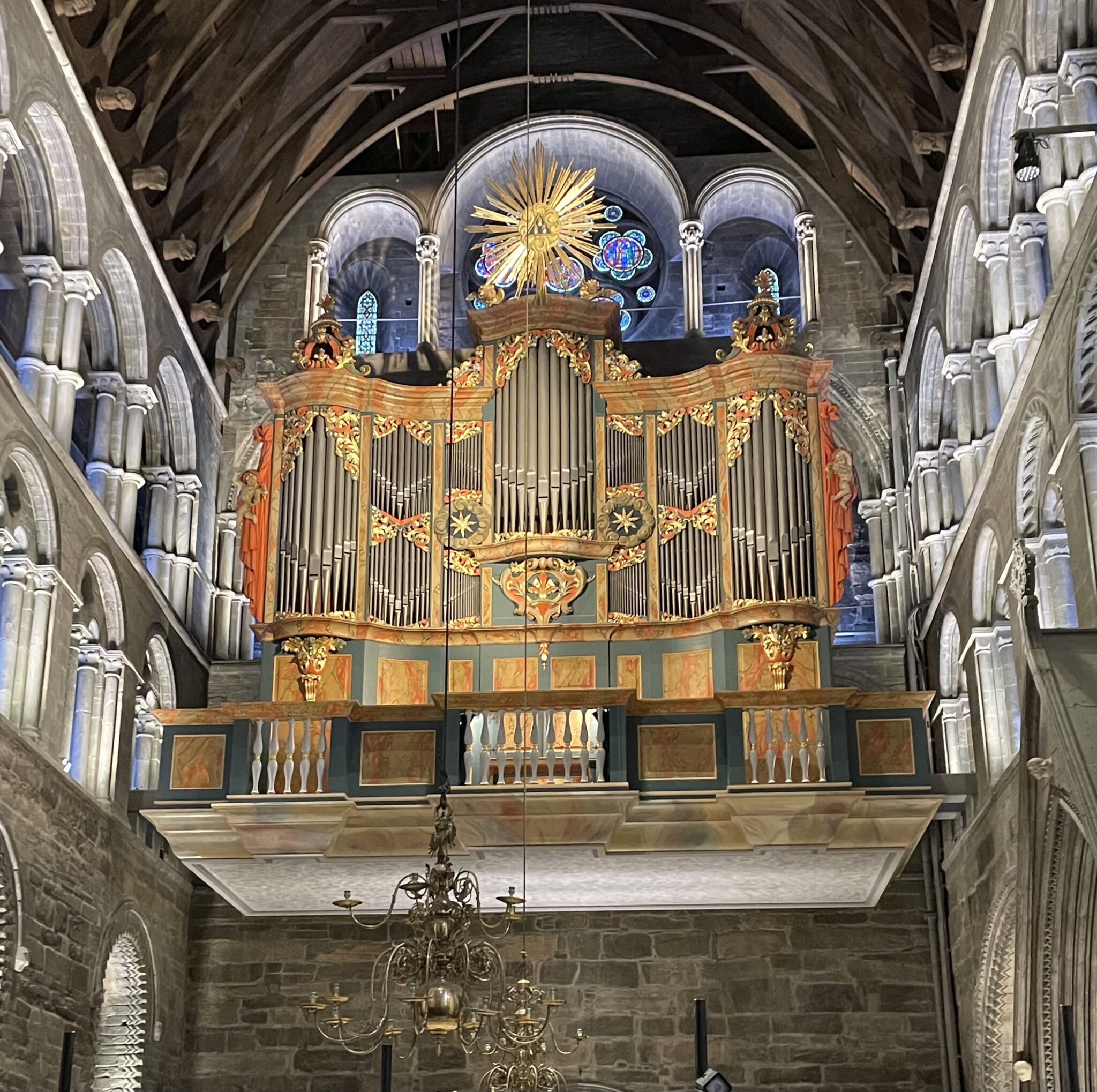
Outside, preparations were underway for OlavFest and a concert. Workers were setting up chairs and on the stage the popular Norwegian singer-songwriter Trygve Skaug practiced and gave pleasure to the mid-morning wanderers.
Trondheim’s Art Museum was just across the square from the cathedral.
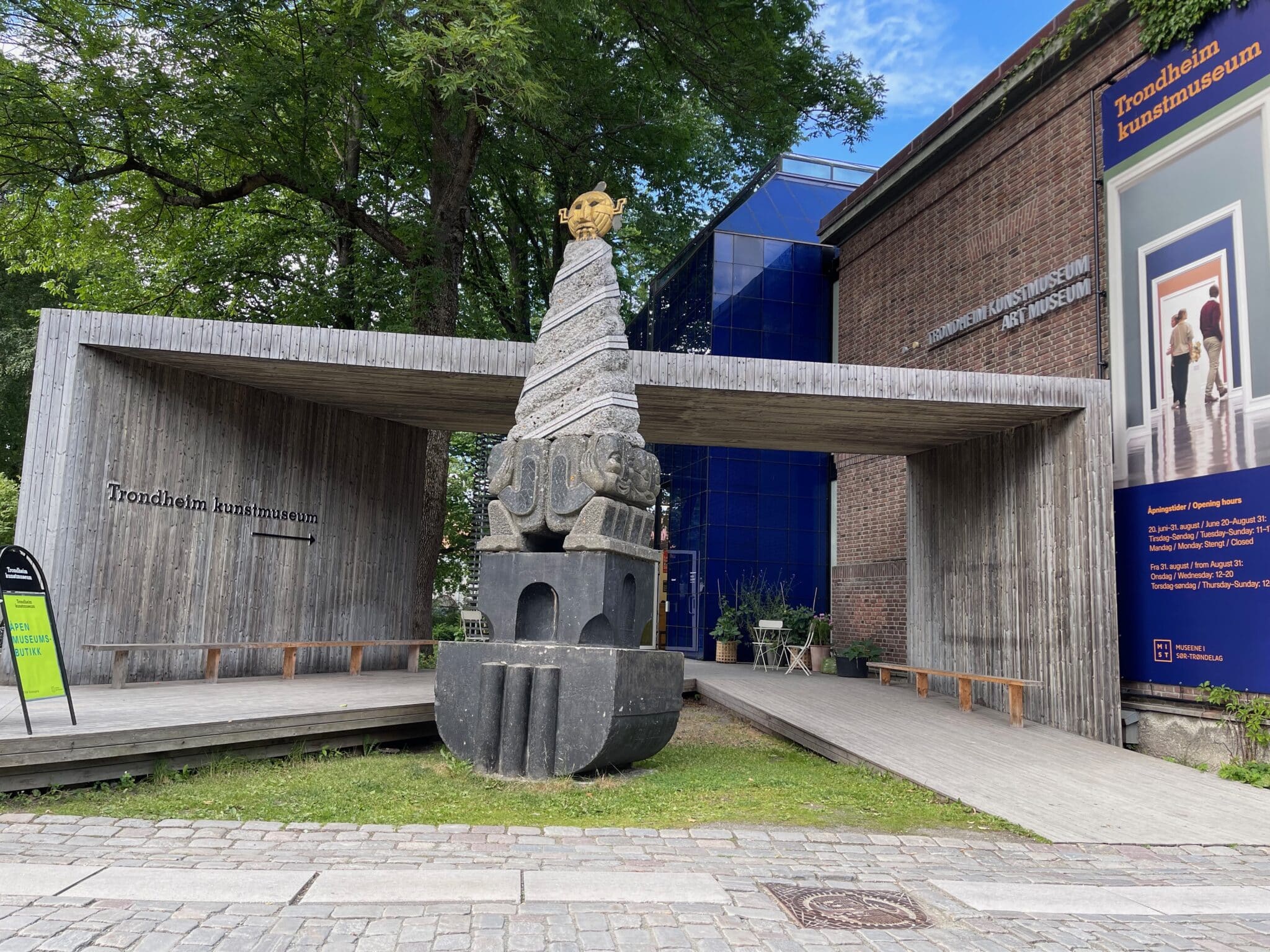 As we entered, a piece of interactive art got our attention. A wall of dartboards and a box full of darts invited us to change the picture ever so slightly.
As we entered, a piece of interactive art got our attention. A wall of dartboards and a box full of darts invited us to change the picture ever so slightly.
A signature exhibit for the summer focused on four Norwegian artists vying for for the Lorck Schive art prize. The foundation sponsors the contest, every other year, and pays half-a-million Norwegian crowns to the winner determined by votes of museum-goers. Each artist had a room to display their work.
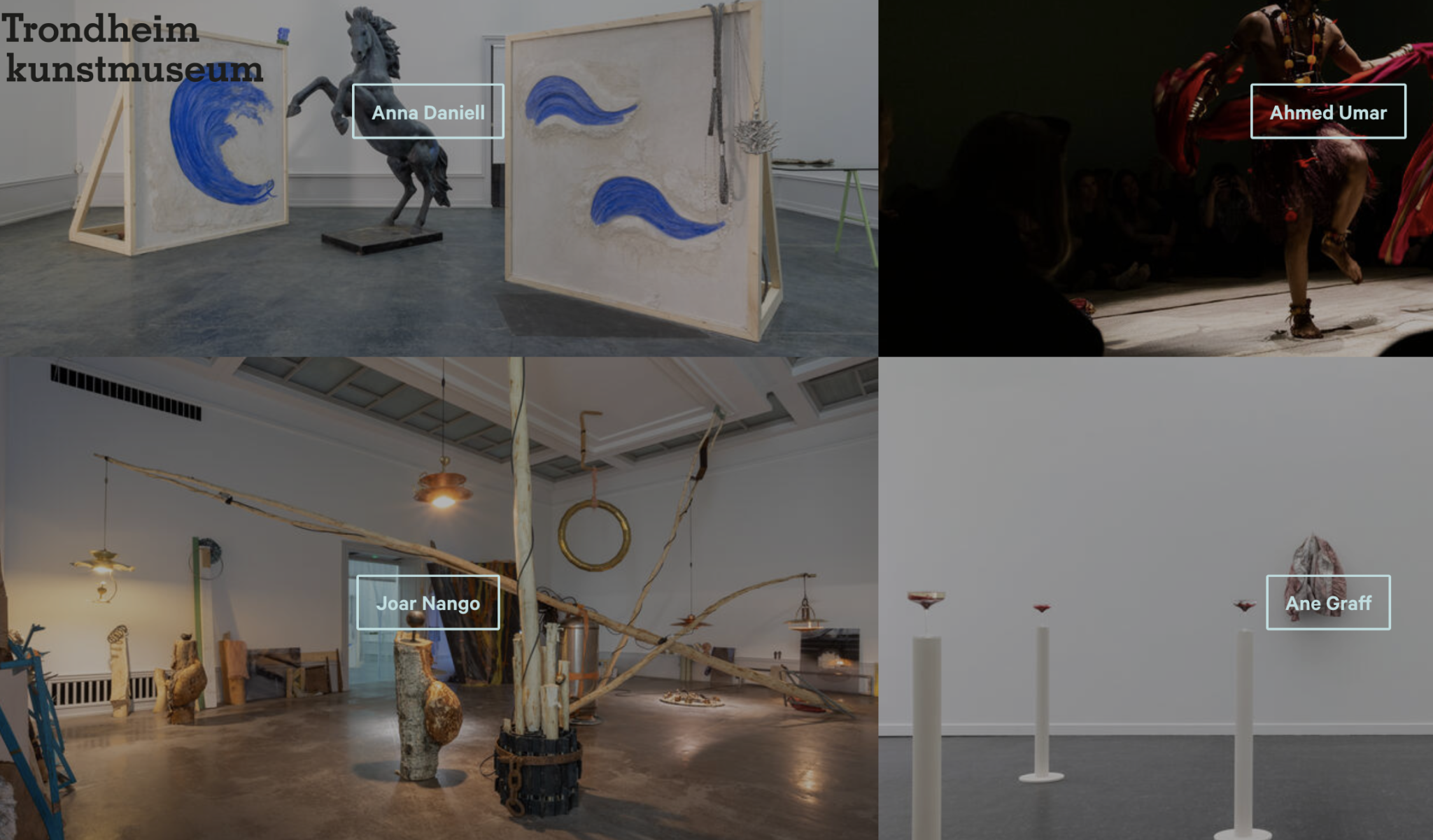
We were particularly interested in the work of Ahmed Umar. He arrived in Norway as a political refugee from Sudan in 2008 and describes himself as an “interdisciplinary” artist. In this exhibit, he used materials and clothing that Sudanese women once wore while they performed a ritual dance before their marriage. The scanty clothing led to a ban on the practice, which he demonstrates in a video that was part of his exhibit.
A box with slots was set up where people were asked to vote on their favorite. We cast our secret ballots and when the results were announced a month later, we were surprised.
It turned out that Joar Nango won the Lorck Schive prize. Nango, a Sámi artist and architect, created an exhibit that reflected the culture in the Sámi area of northern Norway, Sweden, Finland and part of Russia.
One of the judges, Tone Hansen director of Oslo’s Munch Museum said, “Joar Nango examines junctures between indigenous and contemporary architecture as well as traditional Sámi life forms, bringing to light the typology of a sparsely researched indigenous architecture and duodji handicraft tradition. His installation-based exhibitions merge mobile architecture and found materials so as to become a temporary common ground for being together. “
When Nango accepted the prize, worth a little less than $50,000 when it was announced in September, he graciously described his fellow exhibitors as “three other kick-ass artists.” He said he could now replace the clutch on his 30-year-old van and finish building a sauna he’d been working on.
Outside the museum, a craft fair had been set up in front of the cathedral and we wandered through it. Barbara spied a black linen jacket that fit her perfectly and bought it, ignoring my protests that our suitcases were already at capacity.
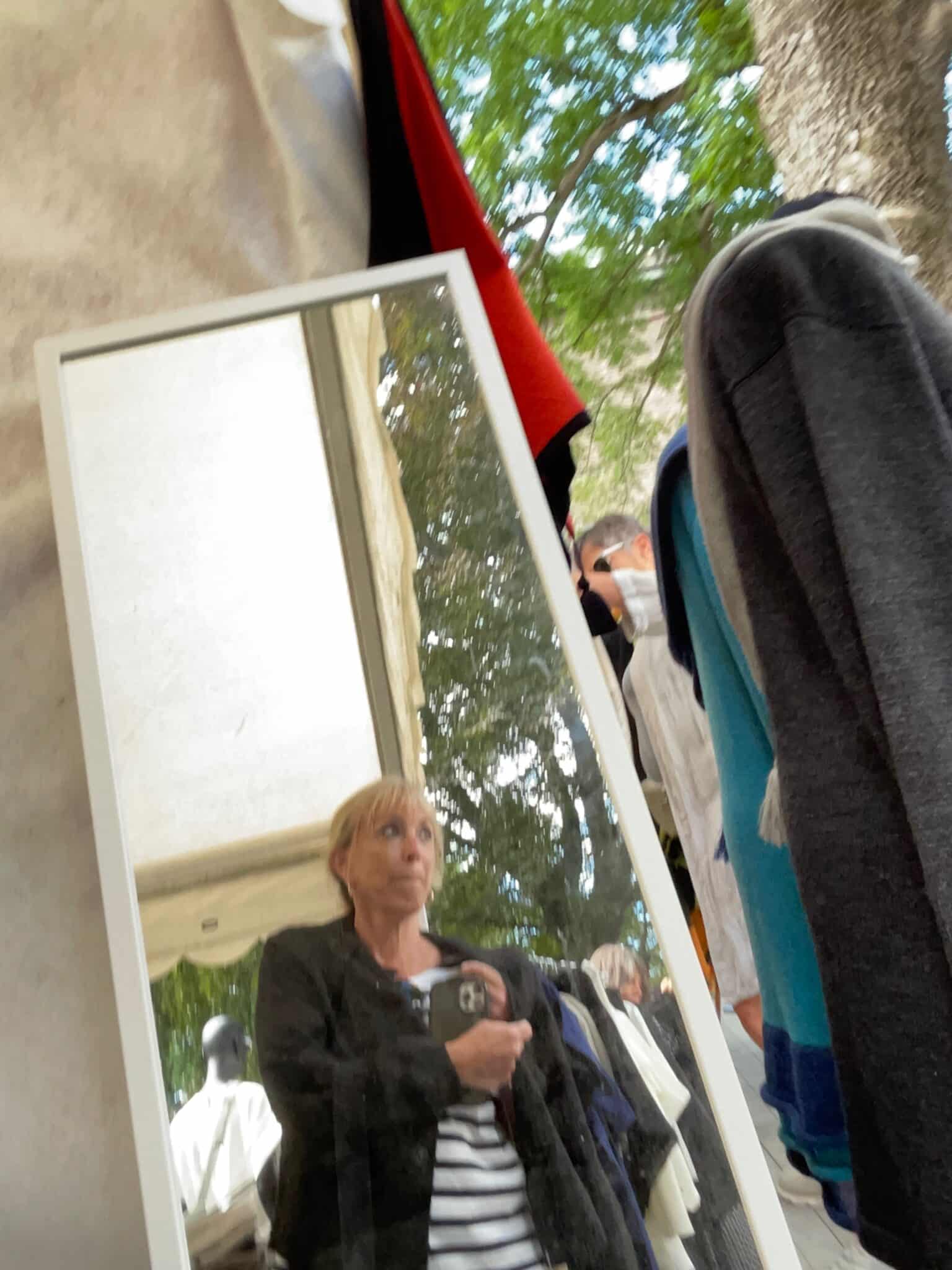
Beyond these booths, we found the another attraction held during the first few days of August of year: the Trondheim Brewery Festival. You could visit tents and sample beers from major companies and specialties from microbreweries. We’re not beer drinkers and it was the middle of the day, so it was lost on us. But hundreds of people were having a very good time.
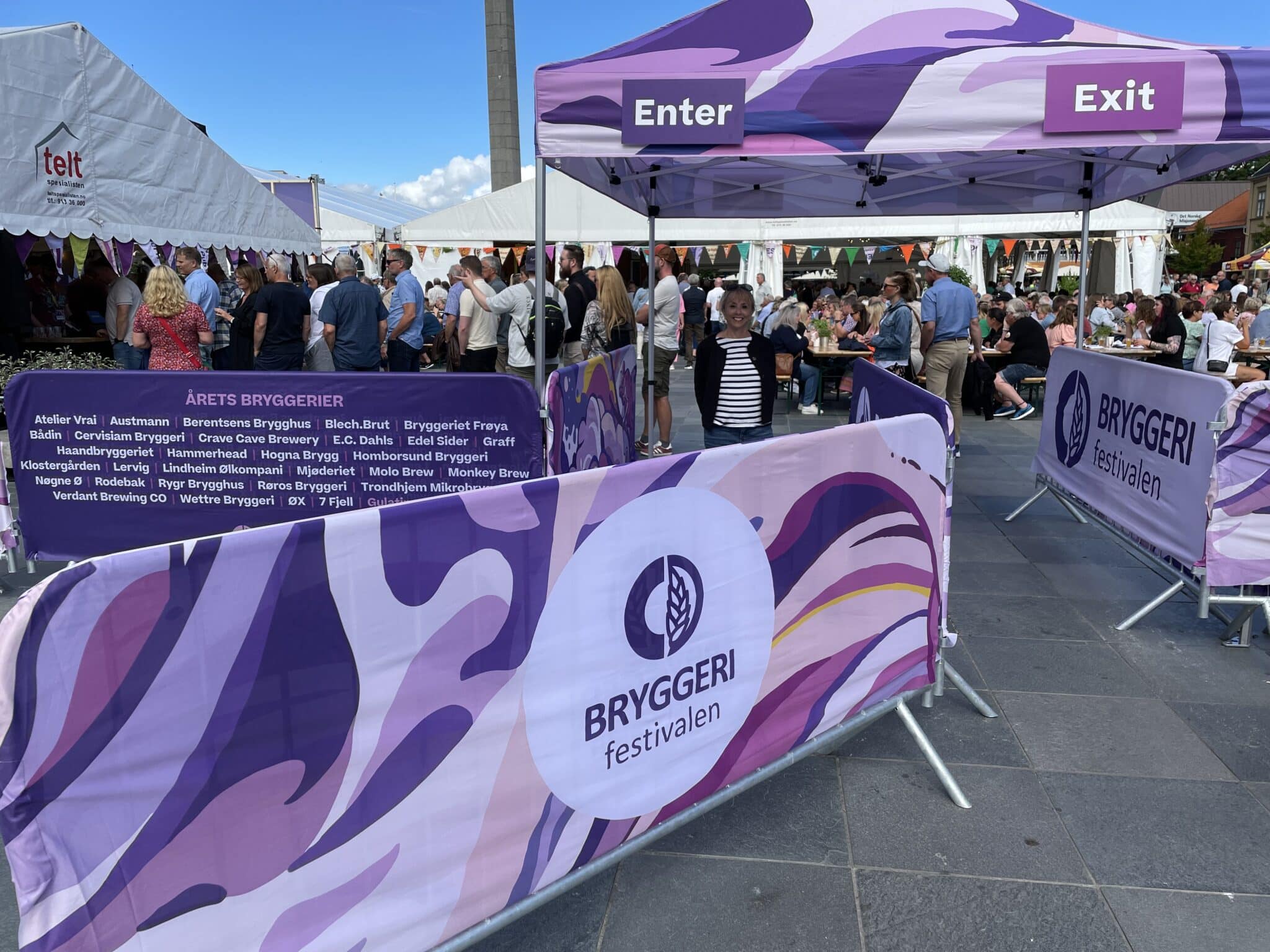
The beer festival coincided with the Trøndelag Food Festival, and its tents nearby featured makers and sellers of regional fish, sausage, reindeer and moose specialties as well as other appealing things to eat and buy.
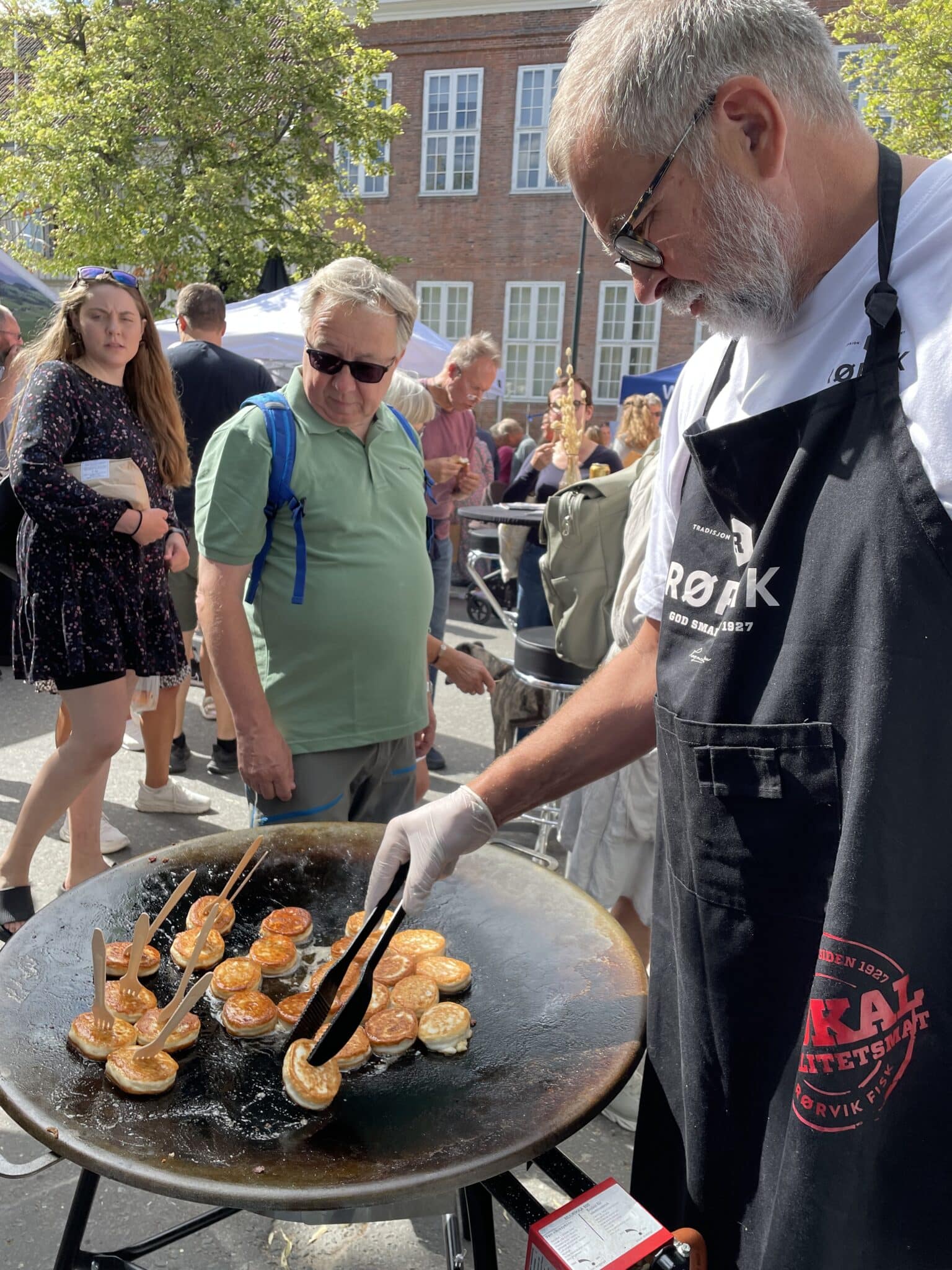
It all made us hungry and a sign promising some of Norway’s best fish cakes caught our attention. They were from Rørvik, a town we’d passed through on the boat the night before. We bought some and sat down to eat them at a nearby table, and they sure tasted like the best in Norway to us.
The fish cakes whetted our appetites for more of the food we might find along the way. Another vendor was at work in the middle of a tent where people waited in line. Grilled chicken and salmon ceviche tacos were on offer. We went for the tacos, and took them outside to find a place at one of the common tables.
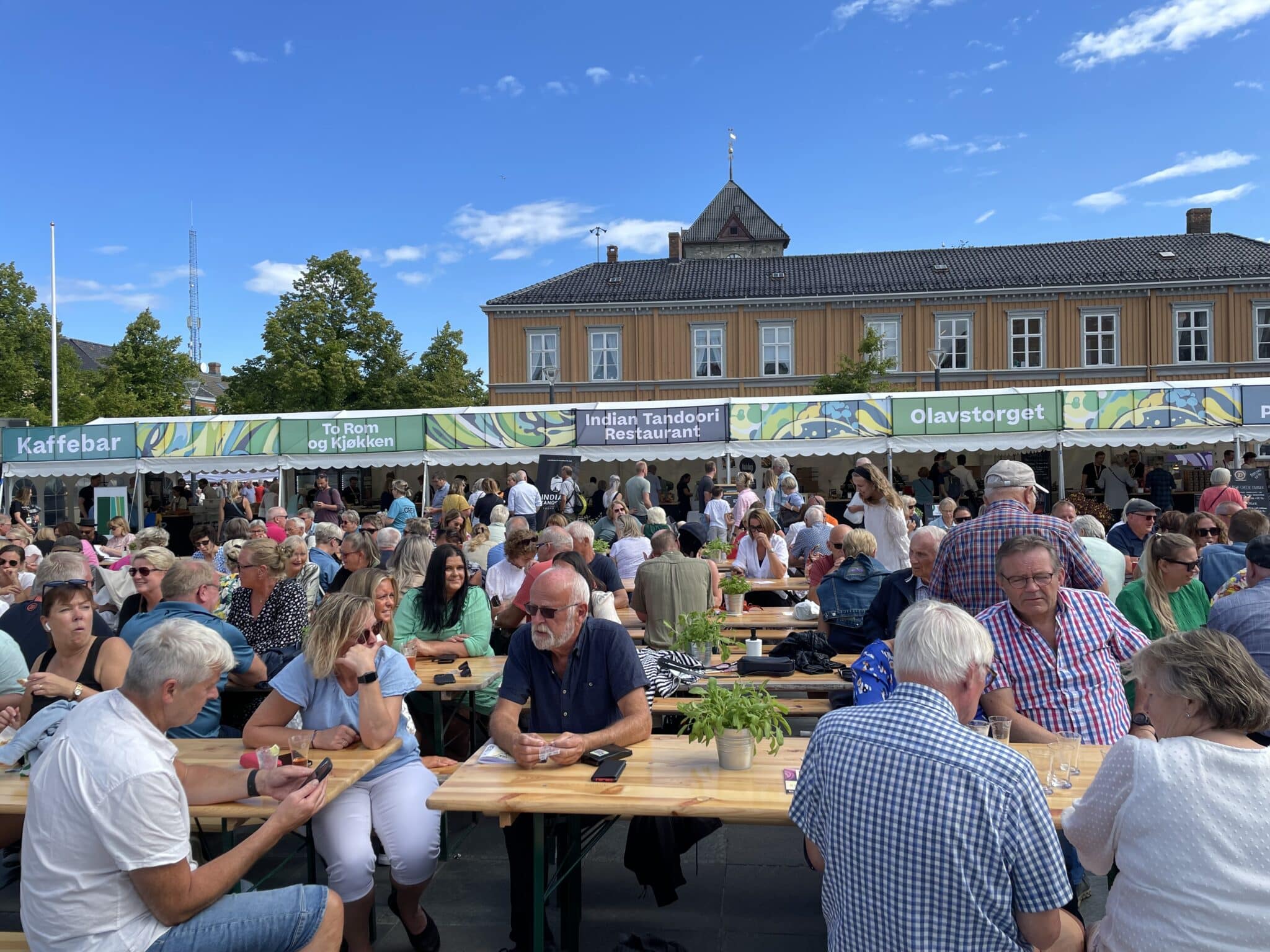
We found a couple of spots at one of the tables, and sat down across from two local men. They were engineers who worked for Norway’s transportation department, and our conversation became lively as they inquired about us and we about them.
The salmon ceviche tacos were amazing. The fresh salmon with lime and the salty, crisp tacos were a perfect combination. We were eating and talking when suddenly a man next to Barbara leaned over and asked to borrow a napkin. Looking at him, she saw why. He grabbed the napkin and wiped at the deposit a passing bird had dropped onto his forehead. He laughed, we laughed and so did everyone nearby. Nick pointed to his baseball cap as a needed accessory for outdoor dining when there were birds around.
We had other fish to fry. We headed back to the tent where To Rom Og Kjøkken was making the tacos and selling them at a fast clip. We raved about the tastes and asked them to book us a reservation in their restaurant for that night. What’s To Rom Og Kjøkken? Two Rooms and a Kitchen, what else?
Before we left the square, we looked up. High above all the fun, and beer and food, King Olav I, Olav Tryggvason, watched over all. He founded Trondheim and began Norway’s conversion to Christianity, often at sword point as the statue suggests.
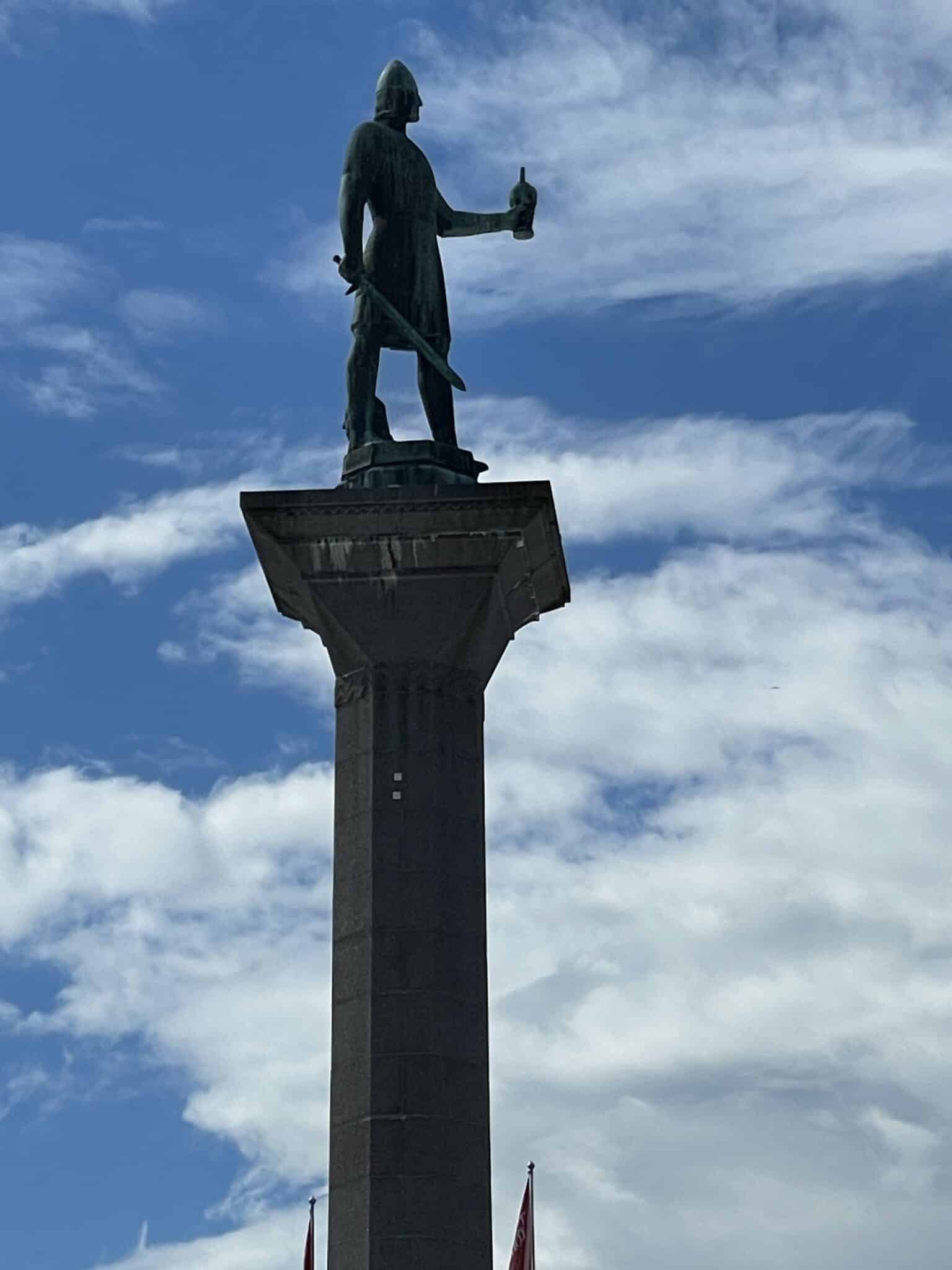
You might not see the head of the pagan god Thor lying at Olav’s feet. But it is there to symbolize Olav wiping away Thor, Odin and Freya, the gods worshipped by the Vikings. King Olav II was gentler in his conversions, resulting in his sainthood.
That night at To Rom Og Kjøkken we found the dining rooms simple with wooden chairs and tables. The food was anything but simple. You could choose a three, five, or seven-course tasting menu with or without wine pairings. We ordered a la carte since we had an early train.
Nick ordered spareribs and a jar with something black in it arrived before the food.
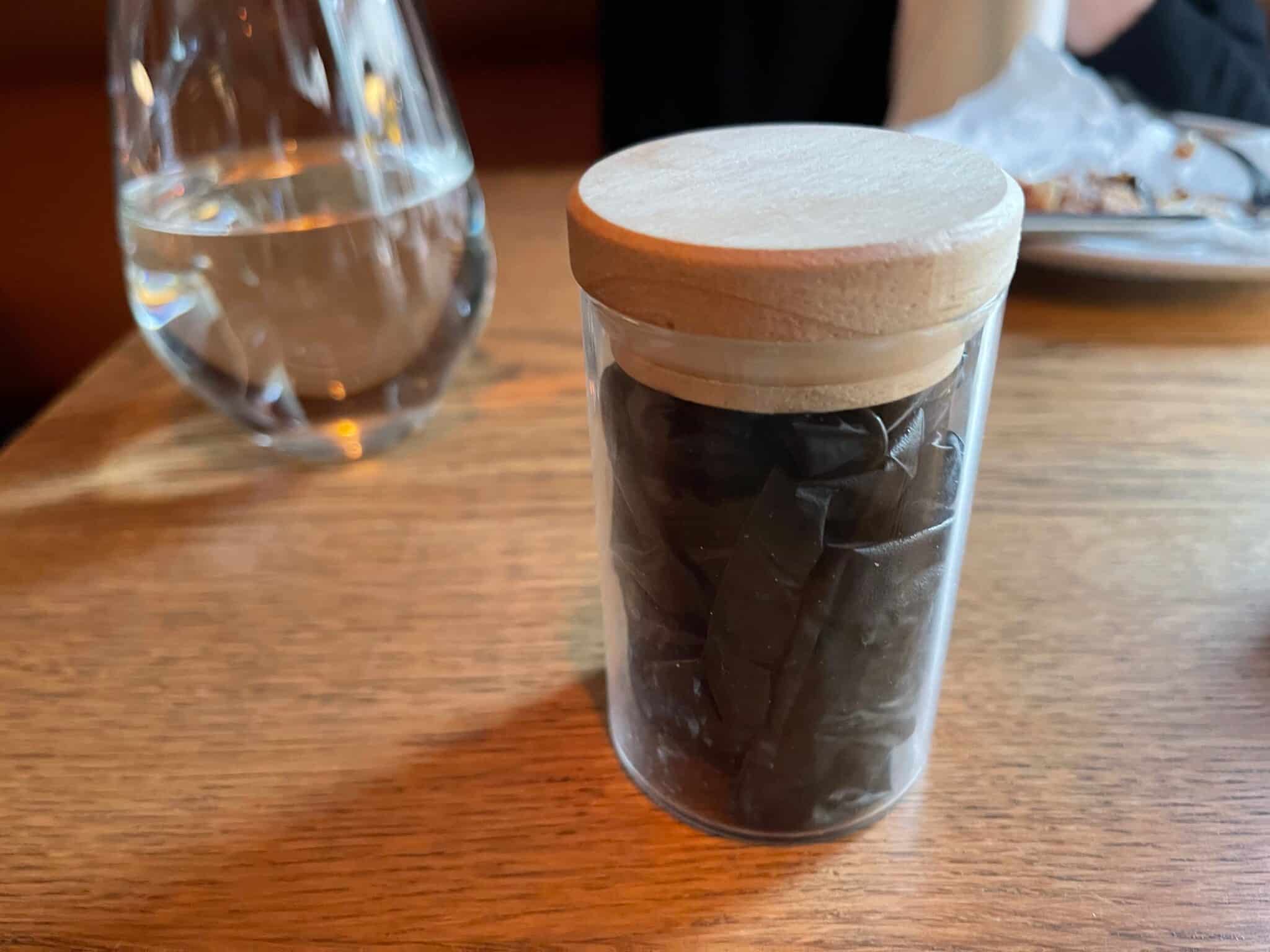
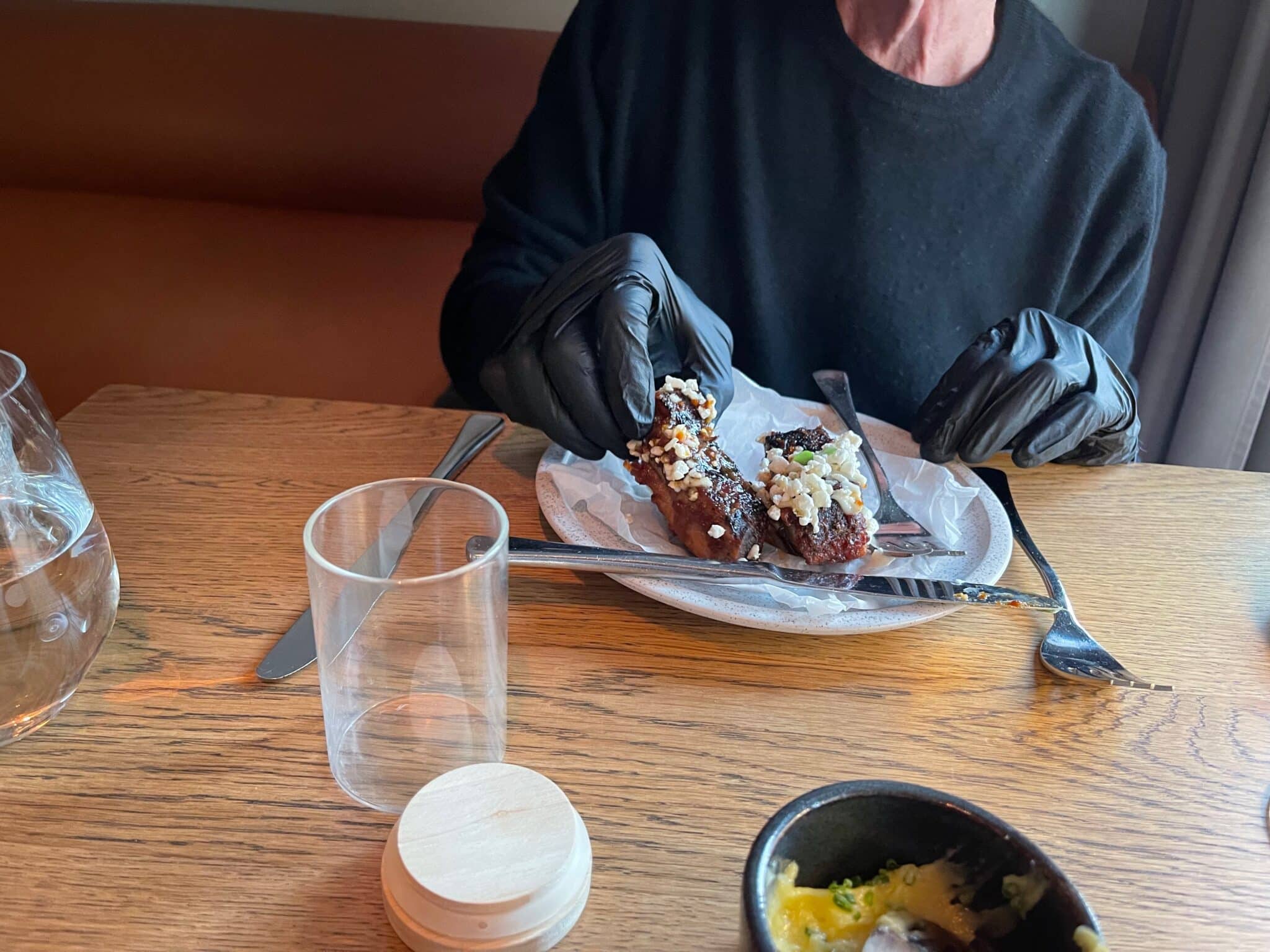
On the Havila Castor and in every restaurant we visited in Scandinavia, there was a careful list of possible allergens in the food. When Barbara told the server that she has a lactose intolerance, the server said. “No problem. The chef will adjust your food.”
So Barbara ordered the Skagenrøe, an open seafood sandwich.
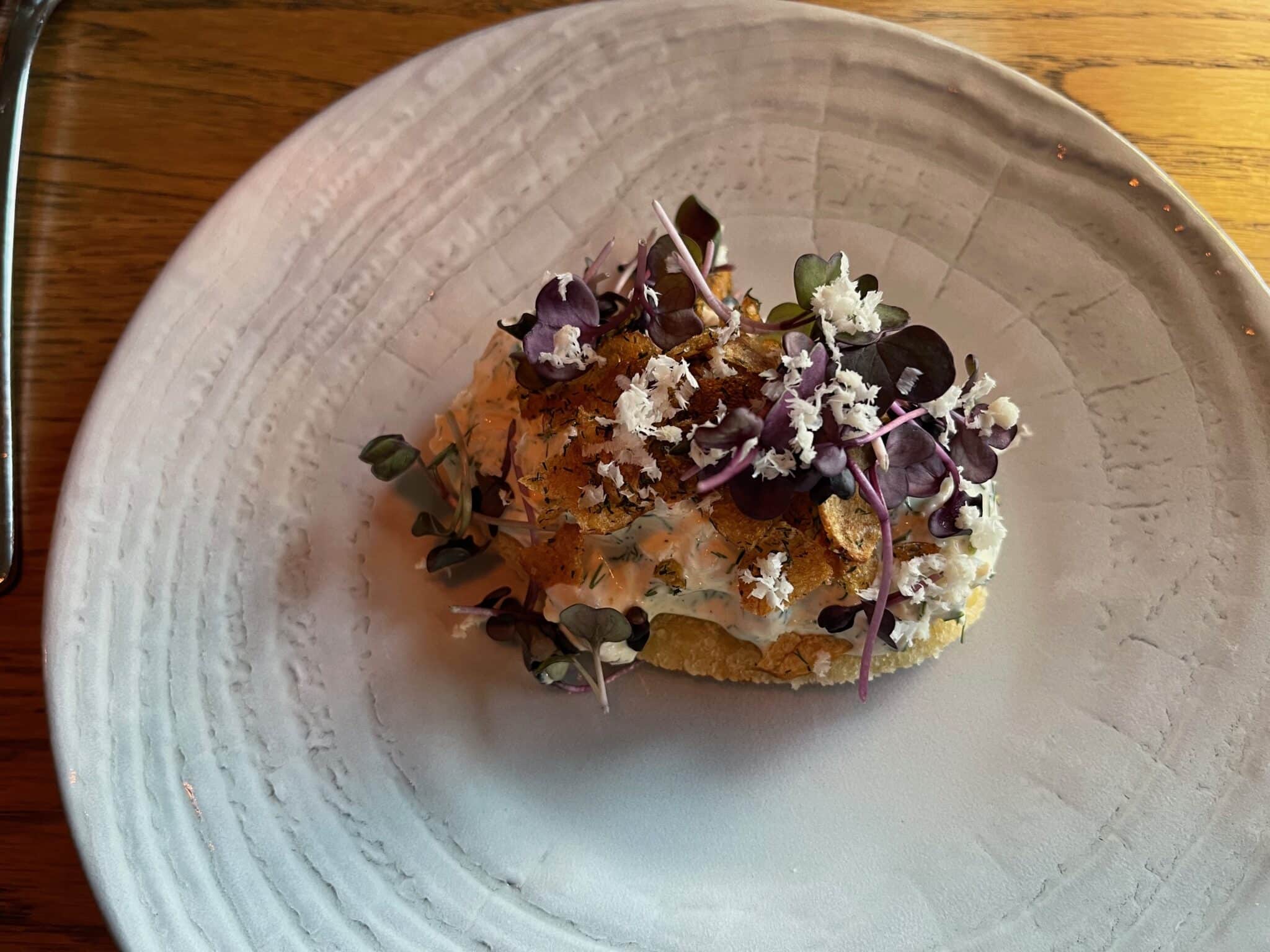
The Skagenrøe was so pretty that Barbara hesitated before digging in. It was as tasty as it looked.
For our main courses, Barbara ordered the Artic char and that too was presented beautifully.
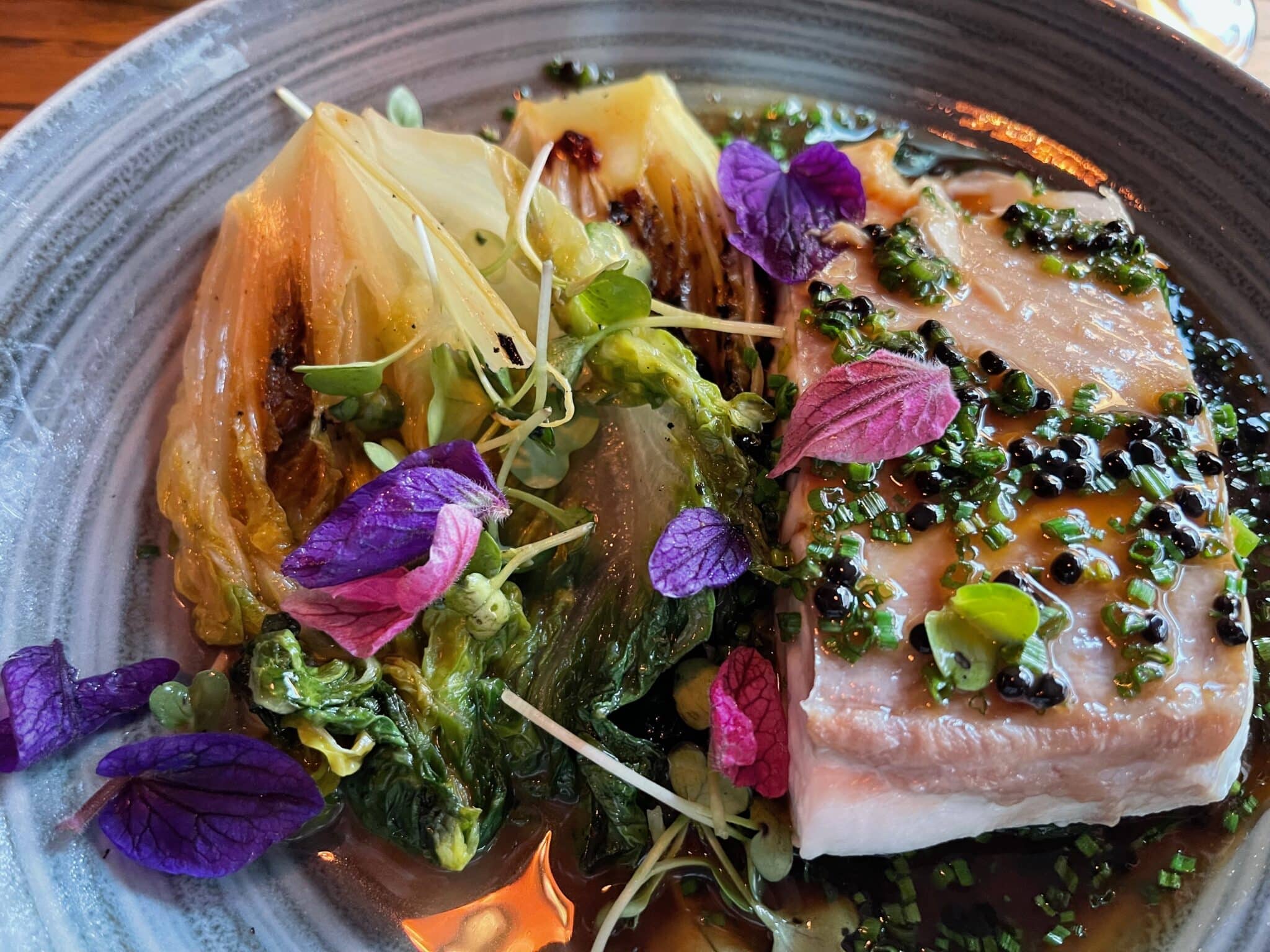
Nick’s highlight was the catch of the day, a whitefish filet in a silky caper sauce.
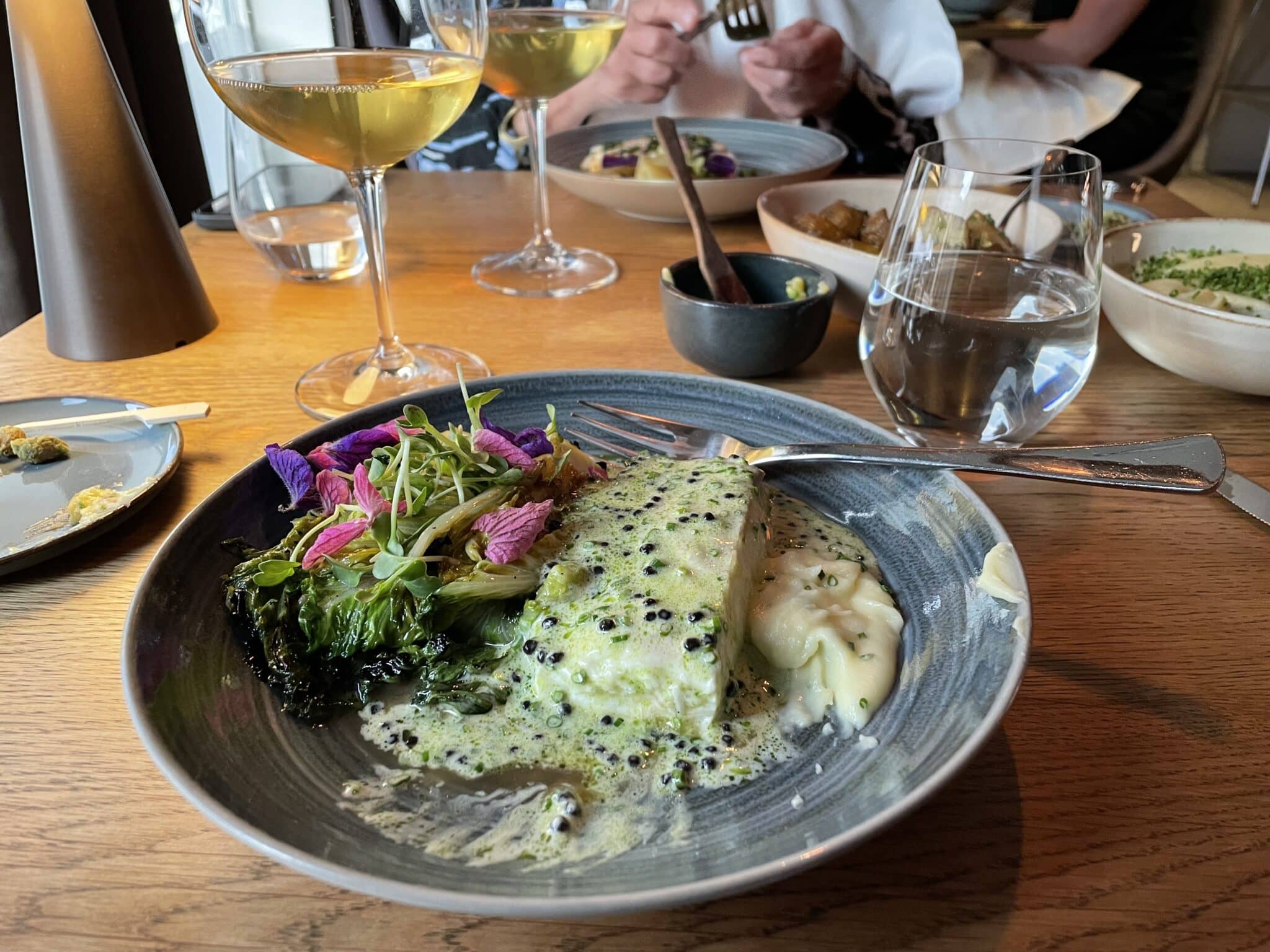
Norway’s 25 percent value added tax runs up the restaurant bills, but even with that this meal, with a couple of glasses of wine, was less than $200. And tipping’s a way to express extra appreciation, not a must as it is in the U.S.
We left the restaurant feeling sated and happy that we had made the decision to spend these 24 hours in Trondheim. Now it was on to Oslo in the morning.
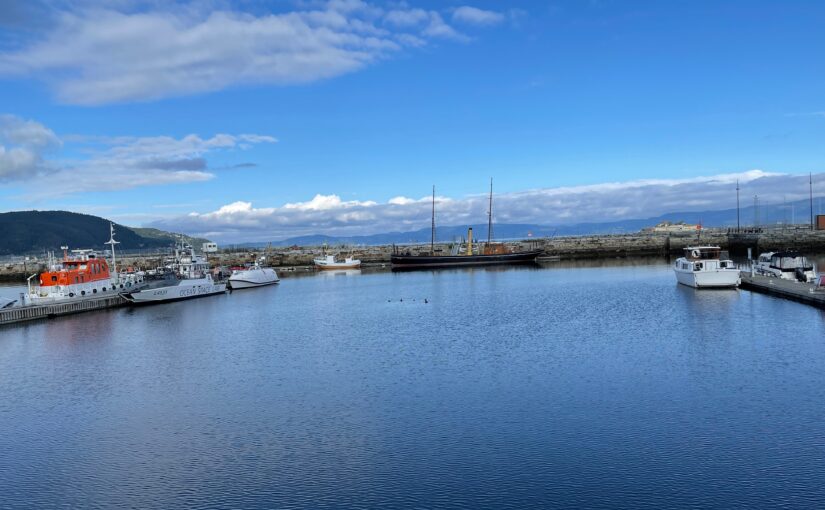
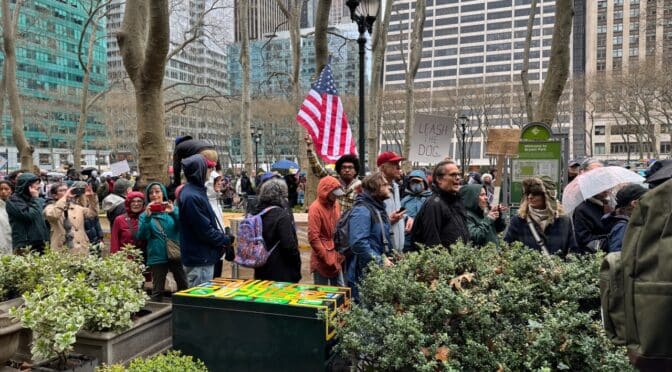
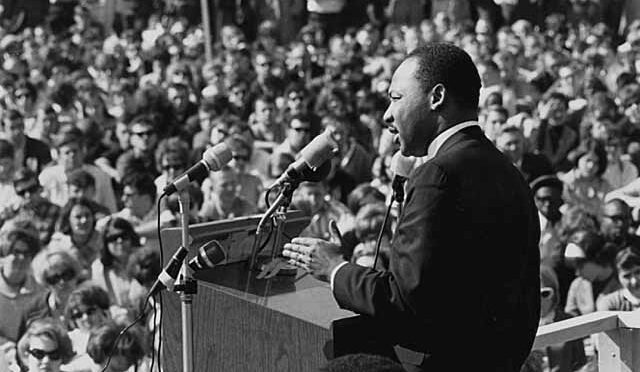

Very enjoyable . Mary and I both have ancestry from Norway- mine 9th century and Mary’s came to US in 19th . We are certain our next trip abroad will be there.
Thanks, John. It’s a beautiful and interesting country, great food, and the people are nice, too. You and Mary will love it.
Love the travel diary. Keep it coming–Barbara and Nick.
Thanks, Ron. There’s more to come!